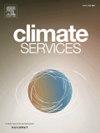Flood evacuation shelter location-allocation considering vulnerability identification in the context of pre-requisition
IF 4.5
3区 环境科学与生态学
Q2 ENVIRONMENTAL SCIENCES
引用次数: 0
Abstract
As China navigates its path to development, rapid growth has been accompanied by persistent challenges, including a widening wealth gap and urban–rural divide, leaving vulnerable populations in towns and villages particularly at risk of flooding disasters. Faced with extreme weather, emergency plans typically fail to account for special-needs groups. Pinpointing the spatial distribution of vulnerabilities and high-risk flood areas, improving the multi-functionality of emergency shelters, and determining the reasonable layout of shelters pose critical challenges in disaster prevention and mitigation. To address the problem of inefficient rural shelter layouts and insufficient protection for special-needs populations, the pre-requisition system, as a part of the emergency planning framework, provides a novel approach. Through scientific planning and resource pre-allocation, before disasters strike, this system can enhance emergency response efficiency and optimize shelter layouts. This study, within the context of this system, presents a shelter site selection decision-making method that combines bottom-up and top-down approaches, integrating vulnerability identification, diverse needs, emergency evacuation zoning, and shelter layout optimization. Using Aba Tibetan and Qiang Autonomous Prefecture in Sichuan Province as a case study, real data were analyzed with ArcGIS software to determine optimal shelter placements. The study verified the necessity of considering the varied needs of affected populations and validates the feasibility of the proposed model through a comparative analysis of coverage results. The findings not only provide valuable insights for targeted planning and differentiated resource allocation in rural areas but also offer support for the practical implementation of the pre-requisition system in shelter locations.
预征用条件下考虑脆弱性识别的洪水疏散避难所位置分配
在中国的发展道路上,快速增长伴随着持续的挑战,包括不断扩大的贫富差距和城乡差距,使城镇和村庄的弱势群体特别容易受到洪涝灾害的威胁。面对极端天气,应急计划通常没有考虑到有特殊需要的群体。确定脆弱性和高风险洪区的空间分布,提高应急避难所的多功能性,确定避难所的合理布局,是防灾减灾的关键挑战。为了解决农村住房布局效率低下和对特殊需要人口保护不足的问题,预先征用制度作为应急规划框架的一部分,提供了一种新的办法。通过科学规划和资源预分配,在灾害发生前,提高应急响应效率,优化避难所布局。本研究在该系统的背景下,提出了一种自下而上和自上而下相结合的避难所选址决策方法,将脆弱性识别、多样化需求、应急疏散分区和避难所布局优化相结合。研究验证了考虑受灾人群不同需求的必要性,并通过覆盖结果的对比分析验证了所提出模型的可行性。研究结果不仅为农村地区有针对性的规划和差异化的资源配置提供了有价值的见解,而且为在安置点实际实施预征用制度提供了支持。
本文章由计算机程序翻译,如有差异,请以英文原文为准。
求助全文
约1分钟内获得全文
求助全文
来源期刊

Climate Services
Multiple-
CiteScore
5.30
自引率
15.60%
发文量
62
期刊介绍:
The journal Climate Services publishes research with a focus on science-based and user-specific climate information underpinning climate services, ultimately to assist society to adapt to climate change. Climate Services brings science and practice closer together. The journal addresses both researchers in the field of climate service research, and stakeholders and practitioners interested in or already applying climate services. It serves as a means of communication, dialogue and exchange between researchers and stakeholders. Climate services pioneers novel research areas that directly refer to how climate information can be applied in methodologies and tools for adaptation to climate change. It publishes best practice examples, case studies as well as theories, methods and data analysis with a clear connection to climate services. The focus of the published work is often multi-disciplinary, case-specific, tailored to specific sectors and strongly application-oriented. To offer a suitable outlet for such studies, Climate Services journal introduced a new section in the research article type. The research article contains a classical scientific part as well as a section with easily understandable practical implications for policy makers and practitioners. The journal''s focus is on the use and usability of climate information for adaptation purposes underpinning climate services.
 求助内容:
求助内容: 应助结果提醒方式:
应助结果提醒方式:


